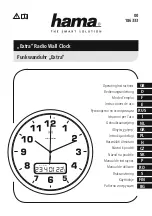
7
GENx192 Studio Master Clock
Hardware and Connections
POWER:
Connect the IEC connector side of the supplied AC cord to the receptacle on the
rear of the GENx192. Connect the other side of the AC cable to an AC power
source that is of the correct voltage and frequency (100-240 VAC, 50-60 Hz). Use
only the power cord and connector specified for the product and your operating
locale.
INPUTS (optional):
If the GENx192 is being used to distribute an existing clock source, connect
that clock source to either the WORD CLOCK or AES input. Both inputs may be
connected simultaneously but only one input may be selected at a time using the
SYNC SOURCE selection knob on the front panel.
WORD CLOCK:
Using a 75Ω coaxial cable (RG-59 or better) terminated with male BNC
connectors, connect one end to any of the eight GENx192 WORD
CLOCK outputs, and the other end into your destination device’s word
clock input. Repeat as necessary to connect additional devices.
AES CLOCK:
Using a 110Ω shielded, twisted pair cable terminated with one male and one
female XLR connector, connect the female end to any of the four GENx192 AES
outputs and the male end into your destination device’s AES input. Repeat as
necessary to connect additional devices.
NOTE :
Be sure that the designated AES input of your destination device can be
configured as an AES sync source for that device.
S/PDIF CLOCK:
Using a 75Ω coaxial cable (RG-59 or better) terminated with male RCA connectors,
connect one end to either GENx192 S/PDIF output and the other end into your
destination device’s S/PDIF input.
NOTE 1:
Many consumer and “pro-sumer” devices do not offer Word or AES clock inputs.
However, of those devices, many do have S/PDIF digital audio inputs, such as the
Digidesign 001 and 002 workstations. These devices typically allow the S/PDIF input to be
a sync source while allowing concurrent audio throughput from both the S/PDIF and other
ports (such as ADAT Optical). If your device fits this profile, the GENx192’s S/PDIF output
will allow that device to finally sync to the outside world!
NOTE 3:
There is no clock-only specification for S/PDIF digital audio, as there is within
the AES specification. Therefore, the S/PDIF output of the GENx192 is simply an
unbalanced, transformer-coupled copy of the AES outputs. Most S/PDIF inputs will
accept the AES-formatted data, but compatilbility is not always guaranteed.


































